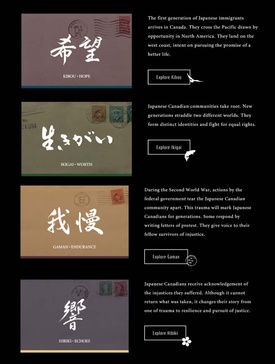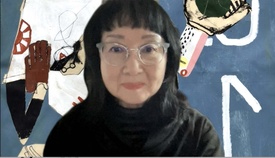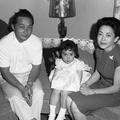Writing Wrongs: Intro to Protest Letters/Paroles perdues : introduction aux lettres de protestation.
© Nikkei National Museum & Cultural Centre, 2021.
I really enjoyed the process of reading through Writing Wrongs. The four “chapters” highlighted different historical moments and the highs and lows for Japanese immigrants. I found the juxtaposition of images from the past and present really interesting and as a constant reminder of the legacy of the Nikkei people in Canada.
Which one of the chapters resonates with you the most? Is there a particular chapter you like? How and why?

Thank you. It really is the entire flow that I am happy with. It’s difficult for me to pick just one chapter but all the chapters that have videos of descendants of letter writers really speak to me. Also, I am particularly proud of how we are able to provide visuals of all of the letters referenced in the final section as well as sample teaching plans so that teachers, students, and anyone wanting to learn more, can dive deeper into the information. Rather than a specific chapter, it’s the videos and heritage galleries that you find in many of the chapters that I hope viewers will take time to view and hopefully find correlations with many of the stories to their lives in present day. We specifically tried to include younger faces/voices alongside videos of elders to give visual reference to the true inter-generational aspects of this exhibit.
Being able to read protest letters from the late 1940s was an eye-opening experience for me. Though I did not read all of them, the sheer volume of the letters really conveys the weight of the injustice that Japanese Canadians had to endure. Although the Redress was achieved in 1988 in Canada, anti-Asian hate incidents have increased since the pandemic. As I read through some of the protest letters and see the violence enacted against Asian communities in Canada today, I fear that history is repeating itself.
How would you say that the NNMCC facilitates and creates spaces of inclusivity, healing and connection through the sharing of stories? What would you like readers to gain from Writing Wrongs?
In addition to being a museum with national scope for Japanese Canadians, we are also a community centre with multi-purpose rooms that we rent out in Burnaby on the traditional, ancestral, and unceded territories of the Coast Salish and Hunkameanam speaking people. We are honoured to live, work, and play on their land. We have a beautiful, accessible facility, and through our programming we do endeavour to offer safe spaces for connection, healing, and inclusivity.
One of the last public programs we hosted before the pandemic imposed restrictions on numbers allowed to gather, was an event called Tsunagu – Inter-generational conversations on Feb 15, 2020 which included 95 participants not including staff. As you’ve noted, racism experienced by letters writers in Writing Wrongs still exists and in many ways is heightened today. At the Nikkei National Museum our social justice advocacy is best served through our exhibits and related programming that allows for dialogue, through public programs like Tsunagu and cultural workshops, and we are committed to offering educational resources to help foster cross cultural understanding.
One silver lining to the pandemic lockdowns was an uptick in folks interested in borrowing our Journeys education kit which is a field trip in a suitcase. These continue to be popular and have been fully booked for the year. We invite the viewers of Writing Wrongs to find their place in the story be it past, present, participant, descendant, bystander, or curious citizen.
Can you briefly tell us about future initiatives at NNM, such as Japan Design Today 100? What can people expect, and how can people stay up to date about the event?
Just as we identify as Canadian, we also identify with our Japanese ancestry and embrace Japanese culture. Exhibits such as Japan Design Today 100 are possible because of support from the Japan Foundation and our wonderful contacts at the Japanese Consulate. First curated in 2004, it was updated in 2014 to include post-2010 objects and exhibited at the Japan Foundation in Toronto that year. This will be the first time that this exhibit will be displayed on the west coast of Canada and will be coming to us from Bolivia. The exhibit covers 10 themes including but not limited to classic Japanese design, furniture, tableware, apparel, stationery, healthcare, disaster relief, and transportation.
In the Fall of 2022, we will launch an exhibit focusing on the art of woodblock prints and washi specifically through the lens of three Canadian artists of Japanese ancestry. Naoko Matsubara and Noboru Sawaii (estate) are two senior artists, joined by Alexa Hatanaka representing a younger generation, in an exhibit called Mokuhan. All three artists share a foundation in woodblock print technique and a fondness for working on washi paper, but interpreted in unique and diverging forms. Also, at different times, all three have worked with the Inuit artistic community in a far northern part of Canada originally named Cape Dorset but now called Kinngait. This exhibit will run August 2022 – February 2023.
I find the Writing Wrongs exhibit an excellent resource that preserves Japanese Canadian voices and one that contains valuable lessons that can be taught in the classroom. Have you connected with certain schools or universities about this project? Do you offer virtual talks? What kind of work can academics, like myself, do to spread the word/knowledge about this project and about the importance of Japanese Canadian history?
Thanks for this question! We are just starting to reach out to schools and universities about Writing Wrongs so any and all help to get the word out is most appreciated. We do have a communication network within Canada, but would love to reach beyond our borders. For example, the Canadian and American experience, while different, have many similarities. I wish this narrative could be shared in other countries with Nikkei but we are limited by language. But perhaps if other countries encouraged learning in English or French, they might find the content a useful teaching tool?
What kinds of projects do you look forward to undertaking/leading in the future?
We have dramatically improved our digital literacy during these pandemic years, and I look forward to the innovative creative outcomes my team has already started on and continue to develop. We remain committed to our mission of honouring, preserving, and sharing Japanese culture and Japanese Canadian history and heritage, and are finessing our strategic plan for the future. And the best part of my work is connection to the Nikkei community. 2022 marks the 80th anniversary of Japanese Canadian internment, so I anticipate a busy, community-filled year to come.
And, finally, any last words?
We know our history is not widely known outside of Canada, so thank you for this opportunity to reach your subscribers beyond our borders. We invite everyone to come visit in person when possible, and to please keep in touch with us through our website and social media platforms.
Thank you for your time.
* * * * *
Nikkei National Museum & Cultural Centre
6688 Southoaks Crescent
Burnaby BC V5E 4M7
centre.nikkeiplace.org
Online exhibition
Writing Wrongs: Japanese Canadian Protest Letters of the 1940s
《Resources for teachers!》
- Neweset digial education resources: Journes Digital Resources
- Sample lesson plans on Writings Wrongs
- The Broken Promises electronic education kit
- Find your Japanese Canadians ancestors
(Landscapes of Injustice Archives) - More resources
© 2022 Mimi Okabe







